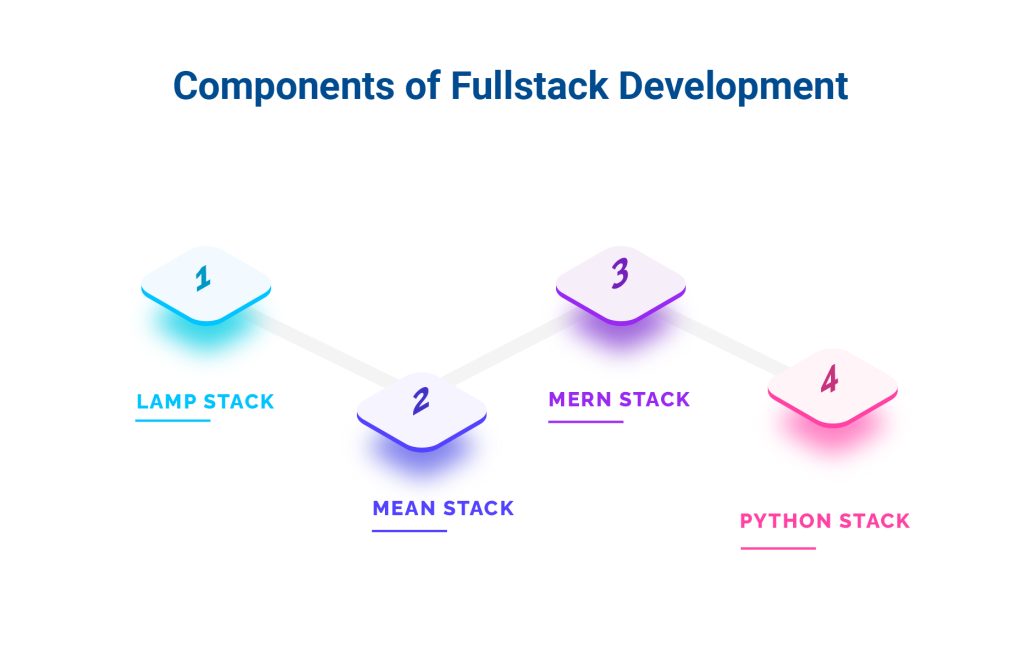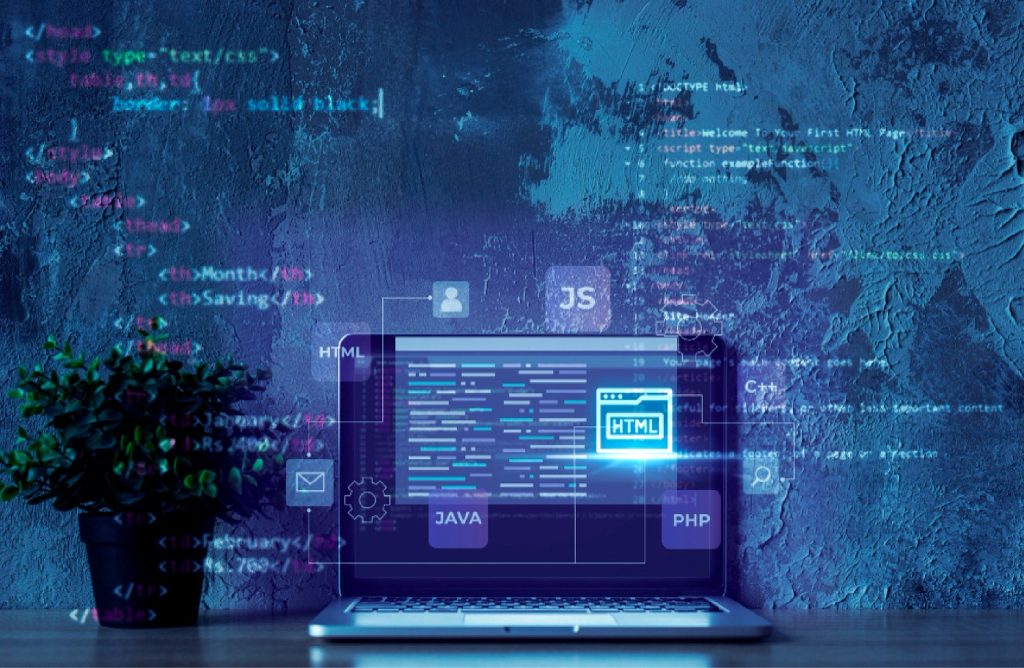Full-stack development plays a crucial role in building robust and scalable applications.
In this blog, we will explore what is full-stack development, and why it is crucial for businesses.
What is Full-stack Development?
Full-stack includes developing both the frontend and backend components of an application.
Frontend deals with the User Interface (UI) and User Experience (UX), while the back end handles the server-side logic, databases, and other server-side processes.
A full-stack developer is proficient in both frontend and backend, making them capable of handling the entire development process from end to end.
‘Stack’ refers to the combination of technologies and products that forms the technical ecosystem. Stack builds the backbone of a product or an application.

Frontend Development
Besides UI/UX, Frontend development includes designing and developing the layout, visual elements, and interactivity that the audience interacts with.
It includes HTML, CSS, JavaScript, and various frontend frameworks like React, Angular, and Vue.
Backend Development
Backend development involves building the server-side logic and infrastructure that powers a web application.
The backend includes handling requests from the front end, processing data, managing databases, and integrating with external services.
Backend technologies include languages like Python, Ruby, PHP, Java, and frameworks such as Express, Django, Ruby on Rails, and Laravel.
Table of Content
- Flutter Vs React Native: Choosing The Right Framework For Your Mobile App
- Introduction To Flutter: Unleashing Cross-Platform App Development
- Mobile App Development Process: 10 Mistakes To Avoid
- Accelerating Change: The Impact Of Mobile Applications On The Automotive Sector
- Leveraging Mobile Apps For Precision Agriculture And Crop Monitoring
- A Step-By-Step Guide To Mobile App Development Process: Part 1
- A Step-By-Step Guide To Mobile App Development Part 2
- Mobile App Development: Unlocking The Power Of Technology For The Modern World
- 14 Must-Have Features For A Successful Mobile App In 2023
- The Ultimate Guide To UI/UX Transformation And Its Benefits For Businesses
Components of Full-stack Development
There are several types of stack technologies; let us explore some of them and their components.
LAMP Stack
LAMP stands for Linux, Apache, MySQL, and PHP. It is a popular open-source stack technology used for building dynamic web applications. The components of the LAMP stack are:
- Linux: Linux is an open-source operating system that forms the foundation of the LAMP stack. Linux provides a stable and secure environment for web application development.
- Apache: It is a web server software that handles HTTP requests from clients and serves web pages to browsers. Apache is known for its flexibility, scalability, and robustness.
- MySQL: It is an open-source relational database management system (RDBMS) used for storing and managing data in a structured manner. MySQL is known for its speed, reliability, and ease of use.
- PHP: PHP is used for building dynamic web pages and applications. PHP is known for its simplicity, ease of integration with databases and support for multiple platforms.
MEAN Stack
MEAN stands for MongoDB, Express, Angular, and Node.js. The components of the MEAN stack are:
- MongoDB: It is a NoSQL (non-relational) database management system used for storing and managing data in a flexible, JSON-like format. MongoDB is known for its scalability, high performance, and ease of use.
- Express: Express is used for building backend APIs (Application Programming Interfaces) using Node.js. Express provides features for building RESTful APIs, handling HTTP requests, and managing routes.
- Angular: Angular is a front-end framework for building dynamic and interactive web applications. Angular provides tools and features for building responsive user interfaces, handling data binding, and managing application states.
- Node.js: It is a server-side JavaScript runtime environment used for building scalable and high-performance web applications. Node.js allows for event-driven, non-blocking I/O operations, making it ideal for building real-time applications.
MERN Stack
MERN stands for MongoDB, Express, React, and Node.js. It is like MEAN but with React as the frontend framework instead of Angular. The components of the MERN stack are:
- MongoDB: Same as in the MEAN stack, MongoDB is a NoSQL database management system used for storing and managing data.
- Express: Same as in the MEAN stack, Express is a popular web application framework for building backend APIs using Node.js.
- React: It is a popular JavaScript library for building user interfaces. React provides tools and features for building reusable UI components, handling state, and managing UI updates efficiently.
- Node.js: Same as in the MEAN stack, Node.js is a popular server-side JavaScript runtime environment used for building scalable and high-performance web applications.
Python Stack
Python stack refers to the technologies that use Python as the primary programming language. There are various components in the Python stack, depending on the specific use case. Some components include:
- Django: It is a popular web framework for building backend APIs and web applications using Python. Django provides tools and features for handling authentication, managing databases, and building scalable web applications.
- Flask: It is a lightweight web framework for building web applications using Python. Flask is known for its simplicity, flexibility, and ease of use, making it ideal for small to medium-sized projects.

Some Examples of Full-stack Development
E-commerce Websites
E-commerce websites require both frontend and backend processes to provide a smooth shopping experience. Full-stack developers handle the frontend UI/UX design and the backend functionality like product catalogue management, payment gateways, and order processing.
Social Media Platforms
Social media platforms require complex functionality. Fullstack developers handle UI/UX and functionalities like user authentication, data storage, and content delivery.
Project Management Tools
Project management tools often require real-time updates and data synchronization between the front end and back end. Frontend development requires UI for project management dashboards and the backend logic for task management, user permissions, and data synchronization.
Booking and Reservation Systems
Booking and reservation systems, such as those used in hotels or event management, require seamless integration between the frontend UI and backend booking and payment processing.
Full-stack developers build the frontend interface for users to make bookings and implement the backend logic for managing bookings, handling payments, and sending notifications.
How Full-stack technology solves modern IT problems?
Businesses face various challenges, ranging from the need for faster development cycles to seamless integration between different components of a web application. Full-stack technology provides a comprehensive approach to address these challenges, offering numerous benefits and solutions to modern IT problems.
Faster Development Cycles
Time-to-market is critical for businesses in today’s competitive landscape. Full-stack technology allows for faster development cycles. A single developer or team can handle both frontend and backend development. This eliminates the need for communication gaps and delays. This results in quicker development and deployment of web applications. Full-stack developers can also leverage pre-built libraries, frameworks, and tools. This accelerates development and reduces time spent on repetitive tasks.
Seamless Integration
Seamless integration between components of a web application is crucial for smooth data flow and optimal performance. Full-stack developers create APIs for seamless communication ensuring efficient data transfer and processing. This eliminates potential data inconsistencies, reduces development effort, and provides a seamless user experience. Full-stack technology also allows for better coordination and collaboration between frontend and backend teams, resulting in a more integrated and cohesive web application.
Flexibility and Scalability
Modern businesses need the flexibility to adapt and scale their web applications according to changing requirements. Full-stack developers, with their proficiency in both frontend and backend technologies, offer the flexibility to switch between tasks and adapt to evolving project requirements.
This allows for better coordination and collaboration between different development tasks, resulting in a more efficient development process. Full-stack technology also provides scalability as businesses can efficiently scale their web applications by leveraging the expertise of full-stack developers who understand the entire system and can optimize it for performance, security, and scalability.
Cost-Effectiveness
Hiring separate front-end and back-end developers can be expensive. Full-stack developers, with their broad skill set, can provide a cost-effective solution. Full-stack technology also allows for efficient resource utilization, as a single team can handle the entire development process, resulting in cost savings for businesses.

Better Understanding of the Entire System
Fullstack developers have a holistic understanding of the entire web application, including both frontend and backend components. This allows them to optimize the performance, security, and overall architecture of the application.
They can ensure proper data flow, implement best practices, and make informed decisions about the technology stack, resulting in a more robust and efficient system. Full-stack developers can also effectively debug and troubleshoot issues across the entire application stack, resulting in quicker issue resolution and improved overall application stability.
Customization and Innovation
Fullstack technology provides flexibility to customize web applications according to specific business requirements. Full-stack developers can create tailored solutions by leveraging their expertise in front and back-end technologies.
This allows for innovation and the development of unique features or functionalities that can differentiate a web application from competitors, resulting in a competitive advantage for businesses.
In conclusion, full-stack technology has become an essential solution for modern IT problems faced by businesses.
It offers numerous benefits, including faster development cycles, seamless integration, flexibility, scalability, cost-effectiveness, a better understanding of the entire system, and customization and innovation opportunities.
Businesses can leverage full-stack technology to build robust, scalable, and feature-rich web applications that meet their specific requirements and gain a competitive edge in today’s dynamic digital landscape.



